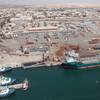In November 1997, Japanese refrigerator ship Kuroshima went aground at Summer Bay near Alaska's Dutch Harbor in heavy weather.
A local USCG team was able to rescue only 16 of the ship's 18 crewmembers. Two perished when heavy seas broke over the ship's bows as it was attempting to reset anchors.
The vessel was eventually salvaged but USCG investigations have disclosed that it was not a smooth operation. According to the USCG, when immediate efforts to remove the ship from the beach failed, Crowley Maritime Corporation was contracted to attempt salvage while a local firm, Magone Marine, was contracted to provide assistance.
Even before salvage terms were agreed upon, representatives of the vessel's owner met with the local Oil Spill Response Organization (OSRO), Alaska Chadux Corporation, and came to a verbal agreement for Chadux to undertake oil spill cleanup efforts as the vessel was known to be losing fuel.
However, a misunderstanding arose under this agreement when the OSRO expected up-front payment for its efforts while the owner's representative assumed it would be billed once the work was completed. The OSRO also expected the owner's representative to pay several subcontractors enlisted in the clean-up effort directly while the owner's representative assumed the OSRO would be paying these subcontractors and later billing the owner.
These initial misunderstandings were cleared up through the assistance of the USCG when a written contract was executed and the ship's owner provided checks that could be cashed in Alaska. Magone was able to safely removed 76,000 gallons of fuel from the ground ship but 46,000 gallons escaped from breached bottom tanks. Most of the latter was recovered by the OSRO team using contract personnel on the beach.
Crowley's salvage tug Arctic Salvor arrived at Dutch Harbor in mid-December but had to wait for a pause in the weather before attempting salvage operations. As Kuroshima was lying parallel to the beach, with the beach on the port side and open water to starboard, the first order of business was to swing the vessel so it was perpendicular to the beach without further damaging the hull bottom.
To accomplish this, a plan was drawn up calling for a system of four anchors attached by wires to portable salvage winches on the bow of the stranded ship, with a single line running from the port side of the stern to an anchor ashore. This succeeded in turning the ship, but with work continually interrupted by a series of winter storms that continued to lash the area, bringing 35-knot winds which dropped the chill factor to below -25 degrees Fahrenheit.
Because of the worsening weather situation, the ship's owner elected to allow Crowley's salvage contract to run out in mid-February, leaving Kuroshima still on the beach and Arctic Salvor returning to Seattle. It was then expected the beached vessel would have to be sold "as is, where is" and broken up for scrap.
However, a break in the weather took place almost immediately after Arctic Salvor's departure and a second attempt to bring the ship off the beach was undertaken by Smit Americas International. A Smit salvage master mobilized local construction equipment and hired two tugs from Dutch Harbor's Padilla Tug Company.
One of these was placed alongside Kuroshima in shallow water and its prop wash used to scour sand out from beneath the stranded hull. At the same time, two backhoes were brought into position by Magone personnel and, with the tug, used to create a floating basin for the reefer with a depth of approximately 10 ft. A channel was then scoured from the basin to deeper water and the ship successfully towed out to sea on March 1, 1998.
Despite spending three months on the sand, Kuroshima was found to be in good condition and was purchased by Seattle's Sunmar Shipping, which planned to repair the ship in a U.S. shipyard and place it under the American flag.
Upon reviewing the Kuroshima incident, the USCG found, in the future, "cleanup operations should not be interrupted by funding issues," and there must be "open communication" between all parties involved in order to avoid misunderstandings.
It also noted OPA 90 established financial responsibility for those who discharge oil and the Oil Spill Liability Trust Fund (OSLTF) as a resource to ensure funds are immediately available to Federal On-Scene Coordinators for removal actions. However, the USCG also pointed out any funds that must be expended under the trust fund are, in turn, to be billed to the identified responsible party - in this case - the owners of the vessel. These lessons are expected to be applied to the next casualty that takes place in U.S. waters.-J.L. Shaw
Sponsored Content
Lower carbon intensity fuels to support your operations

Subscribe for
Maritime Reporter E-News
Maritime Reporter E-News is the maritime industry's largest circulation and most authoritative ENews Service, delivered to your Email five times per week










